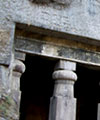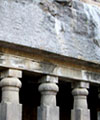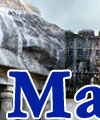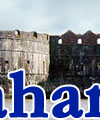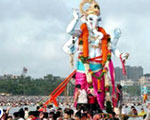|
Pune
Monuments And Forts
[ All Peths in Pune City | Haveli | Sinhagad | Malshej Ghat | Agha Khan Palace | Shaniwar Wada | Shinde Chhatri | Rajmachi | Bedse Caves | Purandar | Junnar | Chaitya Hall | Shivneri fort | Saat Take | Torna | Prachandagad | Rajgad ]
All Peths in Pune City
Peth is the general name for a locality in old Pune. Businesses in many of these localities used to be open for business only once a week. Hence these localities are named according to the day they were open for business. For example Raviwar (Sunday) Peth, Somwar (Monday) Peth, Mangalwar (Tuesday) Peth, Budhwar Peth (Wednesday), Guruwar (Thursday) Peth, Shukrawar (Friday) Peth, and Shaniwar (Saturday) Peth. Some peths have been named after a major temple located within their boundaries (e.g. Kasba Peth, Ganesh Peth, Bhawani Peth), while other peths have been named after certain notable people (e.g. Sadashiv Peth, Nana Peth, Narayan Peth, Ghorpade Peth, Senadatta Peth).
Pune is at the confluence of the Mutha and Mula river,surrounded by hills and lies in the natuaral settings having pleasant climate. Pune is a significant milestone in the history of India. For many years Pune was the pulse of the Maratha land and has given India some of its most memorable personalities. Raja Shivaji, the Maratha king who defied the Moghul emperor Aurangzeb was brought up in Pune. The city also served as the Head quarters of the mighty Maratha Empire under the Peshwas. After the fall of Maratha Power, Pune became an educational centre. Many social reforms were initiated in Pune. During the lifetime of Lokmanya Tilak, Pune had became the nerve of national politics. The city has provided many social reformers,revolutionaries,political leaders, researchers, scientists educationists,and players.
Pune today, is very much a modern city,but still retains its quaint old values and traditions. It is one of the fastest growing industrial area.Pune is the cultural capital of Maharashtra. It boost a fine University and number of educational institutions. It is a Military Cantonment,the Head quarter of Southern Command of Indian Army, Air base for Jaguar,Mig29 and Su30 Aircrafts of Indian Air Force
Top
Haveli
For a period of over one hundred years the district of Pune has been a bastion of the all-powerful Maratha empire. Pune District is marked by numerous awesome land and sea forts, a testimony to Raja Shivaji's daring exploits. Later, Pune was handed over to the Peshwa family, whose Maratha power rose to be a major political force. In 1818, Pune was taken over by the East India Company.
The cultural capital of Maharashtra, Pune is just 170 kms from Mumbai. In fact, Pune exemplifies an indigenous Marathi culture and ethos, in which education, arts and crafts, and theatre are given due prominence. It has one of India's oldest universities and numerous colleges catering to Indian and international students. Small when comapared to Mumbai, Pune's old city area is peppered with narrow and winding roads but the newer areas are more open and spacious. Though mostly populated with a Marathi-speaking community, Pune is slowly becoming a more cosmopolitan city.
Today, Pune is an important commercial and educational centre with distinctive features and characteristics of its own including the omnipresent 3 wheeler auto-rickshaws and cyclists and a daily siesta hour which is taken very seriously.
Top
Sinhagad
Sinhagad is 25 Kms. from Pune. Sinhagad is a favorite Picnic Spot for Puneits. It is famous for trip - lovers as well as for the trekkers - especially for Katraj to Sinhagad trek . Sinhagad is 700 mtrs. High but can be reached by vehicle also.
Now a days, Sinhagad is famous for lovers. But it has historical importance and who will forget the brave Tanaji Malusare, Shelarmama and their historic battle. You can see Tanaji's samadhi on the fort. The bungalows of Lokmanya Tilak and famous Marathi Poet G.D. Madgulkar ( Ga Di Ma ) are also located on the fort. Dev Take - famous tank with sweet and cold water - is popular amongst the tourists. Sweet curd, Buttermilk, Kanda bhaji and Pithle-Bhakari of Sinhagad is the main attraction for the people. The samadhi of Rajaram Maharaj can also be found on this fort.
The tower of Doordarshan -Mumbai is also there on Sinhagad. This tower provides reception to Pune region. You can see the Panshet, Khadakwasla and Varasgaon dams and Torana fort also. The view of entire Pune city looks wonderful. The trip Pune - Sinhagad is very intensity because of the Ghat to Sinhagad and one must enjoy the trip.
Top
Malshej Ghat
Apart from Lonavala -Khandala, Matheran and Mahabaleshwar this is one of the developing hill station in Maharashtra. Malshej Ghat is situated on the borders of Pune , Thane and Ahmednagar districts. A very popular place as it is close to both Pune and Mumbai. Malshej Ghat is vital place in Sahyadri hills and really very attractive when it is under dark clouds and heavy fog. Heavy fog and amazing waterfalls are the spatiality of Malshej Ghat especially in monsoon.Maharashtra Tourism Development Corporation ( M.T.D.C. ) has its rest house in Malshej. It is situated in hill station's platue between HarishchandraGad and the other hill ranges. A nice view of valleys is one of the major attraction here. One of the beauties here are many waterfalls in the hilly regions. Various waterfalls from small up to the huge ones are really worth to see.Malshej Ghat is for also famous for dark woods and the animals inside. These animals includes tigers , leopards , rabbits and peacocks etc. But truly a famous place near Malshej Ghat is Khireshwar which is 2/3 kms from rest house. The place is famous for Hemingo birds. These birds comes here every year from Siberia between July and September. Its really an amazing view. Through Khireshwar village, one can visit the famous Harishchandragadh also.Truly, Malshej Ghat is one of the popular hill station in Maharashtra because of the beauty of nature, huge ranges of Sahyadri, amazing view of Harishchandragad and many other forts.
Top
Agha Khan Palace
Located on the Ahmednagar road, this Palace boasts of Italianate arches and a royal abode. The vast area houses a gracious building having salons and suites and spacious lawns. The place has a historical landmark. During the 1942 Quit India Movement, the British interned Mahatma Gandhi and his wife Kasturba Gandhi here. Later a memorial was erected here, in the memory of Kasturba Gandhi who died in this palace.
Top
Shaniwar Wada
Built by The Peshwas in 1736, this magnificent fort rests in the heart of the city. It houses a palace that was the residence of the Peshwa family. The impressive brass studded gates and lotus pools have withstood the ravages of time. This fort has become an integral part of the culture of Pune. The PMC has accomplished the tough job of reviving and imparting the fort its lost glory. The 'Light and Sound Show' strives to take you down the nostalgic.
Top
Shinde Chhatri
Among the architectural sights you shouldn't miss is the memorial to the Great Mahadji Shinde. You can see the warrior's painted likeness in silver, swathed in a flame coloured turban and an elaborately worked shawl. At his feet are his original puja vessels, used to propitiate his family deity each morning. A painted sign requests you not to open an umbrella within the Chhatri's precincts as it would be insulting to the great warrior's memory. This monument was built as a tribute to the great Maratha nobleman Mahadji Shinde who was the Commander-in-chief of the Maratha Army under the Peshwas.
Top
Rajmachi
55 kms from Pune is Rajmachi. It is just 20 kms from Lonavala. An easy trek through the Tungarli lake takes you to Rajmachi. The way is too far but still interesting. You come across forest, waterfalls and Tungarli Lake on the way. Rajmachi of comprises two peaks viz Shrivardhan and Manaranjan. 3250 feet high Shrivardhan is called the Bale Killa of Rajmachi. It was built to keep a close watch on Konkan. Manaranjan is 2700 feet high, with several water tanks, strong walls and with 3 doors. Points like Bhimashankar, Matheran, Nagphani and Karnala can be seen from here. Khondave Caves and Bhairoba Temple are also famous over here.
Top
Bedse Caves (Old Caves near Malavali)
Bedse falls 8-10 Km south of Rautwadi which is in Kale Colony while going towards Phagana Dam on the river Pawana near Kamshet.Bedse Caves is one of the few places less crowded and worth visiting. People do know about the Karle-Bhaje caves near Pune but have hardly heard of Bedse Caves. Truly trio logy of the caves in Mawal Region can't be completed without Bedse. Bedse Caves are not more than a 20-25 minutes of walk from village Bedse. They are facing east so it is obviously advisable to visit the caves early morning as in sun light the beauty of carvings is doubled. The period can be traced back up to 1st century b.c. A very famous incidence is told about the caves. Till around 1861 the details in paints, the carvings on the walls and the stupas were in proper stage. A British officer after hearing about this arranged his visit there. When local officer came to know about this, he urgently employed labour and clean the caves and painted the walls. The Caves today are not well cared of. But still their beauty definitely catches hold of an aesthetic mind.
Top
Purandar
Some part of Purandar is covered with Forest. The trees found in the forest are Sag, Teak, Oak, Mango. Rabbit, Deer, Wolf, Fox, Tiger and Leopards are the wild animals found in this area. Peacock, Bulbul, Parrot are some of the birds found in this area. In this region crops like Sugarcane and Bajara are grown. Vegetables like Onion are also grown here. The famous Purandar fort and Memorial of Sopan Deva and famous temple of Jejuri are the best attraction of this place.
Top
Junnar
Junnar is a city in the Pune district of the Indian state of Maharashtra. It is a taluka headquarter. Situated at the base of the Sahyadri mountains, it is situated around 100 km east of Mumbai and 94 km north of Pune. Located near this city are Shivneri Fort, birthplace of Shivaji, the famous Maratha king, and Lenyadri, one of the Ashtavinayakas. The land surrounding Junnar is very fertile and the main crops harvested are rice, wheat, and sugarcane. On Sundays are the weekly market where locals purchase fresh fruits and vegetables. Junnar is also famous for its Ganesh decorations during the Ganesh festival, being sometimes compared with the decorations in Pune and Mumbai during the festival. Junnar taluka in Maharahtra has the largest density of leopard population within a 500 sq. km area. It also holds the record for the largest number of leopards trapped within that range ever. Much greenery and dams, such as Vadaj and Manikdoh, common picnicking locations also surround Junnar. Also present are the very famous Naneghat ancient caves.
Junnar, is 177 kms from Mumbai, on the Mumbai-Aurangabad route. It is a birthplace of the Maratha chieftain Chhatrapati Shivaji. The hills surrounding the plains of Junnar are honeycombed with a cluster of Buddhist caves, which are divided into three distinct groups. 5 km to the west are the Tulija Lena Group which has a circular dome ceiling in the Chaitya Hall (cave No 3). The second group of caves are located 1.5 kms south of the town, towards the Manmodi Hills. The third group, Ganesh Lena Group is located 4 kms south of Junnar There are a large number of small cells and viharas in the group, the principal being the Chaitya Cave No.6 and the vihara now known as the Ganesh Lena.
Areas under Junnar:
Amrapur,
Narayangaon,
Kusur
Junnar Caves
Junnar caves are also an important destination for the Buddhist pilgrims, not very far from Mumbai; these caves are situated in Aurangabad district, and are well known to the tourists, especially the Buddhist pilgrims around the world. There are many caves in the hill ranges, all-important in the archaeological point of view.
There are three groups of caves in the hills, the Tulija Lena, and the Ganesh lena being prominent. The place is surrounded by lush greens, which makes the place more attractive and a dear one among all Buddhist destinations.
Top
Chaitya hall
The Chaitya hall is very attractive and special. It has a circular dome ceiling, and lies within the Tulija lena Group of caves. The Chatya hall is spacious and different from most of the other Chaitya found in caves of India. The second groups of caves lie towards the Manmodi hills and are also quite important archaeologically. The caves are well preserved and special for the archaeologists, who visit to testify the sculptures and images in the caves.
The Ganesh Lena caves are also quite beautiful and attract a lot of tourist population. It also has a Vihara, known as Ganesh Lena, many small cells and chaityas. The cave no 6 which, also houses a chaitya is special and a must for any visitor.
Top
Shivneri Fort
Junnar is a city in the Pune district of the Indian state of Maharashtra. It is a taluka headquarter. Situated at the base of the Sahyadri mountains, it is situated around 100 km east of Mumbai and 94 km north of Pune. Located near this city are Shivneri Fort, birthplace of Shivaji, the famous Maratha king, and Lenyadri, one of the Ashtavinayakas. The land surrounding Junnar is very fertile and the main crops harvested are rice, wheat, and sugarcane. On Sundays are the weekly market where locals purchase fresh fruits and vegetables. Junnar is also famous for its Ganesh decorations during the Ganesh festival, being sometimes compared with the decorations in Pune and Mumbai during the festival. Junnar taluka in Maharahtra has the largest density of leopard population within a 500 sq km area. It also holds the record for the largest number of leopards trapped within that range ever. Much greenery and dams, such as Vadaj and Manikdoh, common picnicing locations also surround Junnar. Also present are the very famous Naneghat ancient caves.
Location
This is one of the 4 forts, which guards Naneghat - the ancient trade route between Junnar (plateau) and Kalyan, Nalasopara (both in Konkan). Reaching Junnar, one has to catch bus to reach village Chavand that is only 17 km NorthWest of Junnar. Reaching the village, walk for about 20-25 mins to reach a school at the base of fort. From here, one can reach the top in an hour.
Top
Saat take
The greatest attraction of this fort is probably 7 big water tanks (Saat take). Though not potable, this tank contains ample amount of water even in the summer.
The fort has a one Darwaja (gate) in a good condition. Remnants of a Mahadev temple are found atop and water tank next to it.
Chavandai temple (10 min from Saat take) with a Deepmal marks the highest point of the fort.
Top
Torna
Torna One of the highest forts in Maharashtra, this fort were Shivaji's first major conquest. He rebuilt it by repairs and made it his base. Shivaji had apparently abandoned this fort for Raigadh after finding it to be vulnerable due to its open summit. This fort offers a lot for trekkers, as it has one of the most exciting treks. A two-hour bus ride from Swargate will take you to Velha village, where the imposing fort rises out of the outskirts of this village! Not a fort for everyone, this trek needs to be attempted only for true-blue trekkers, as the fort does not offer any shelter or food! Though what it does make good for is the fantastic viewing of the surrounding forts! A true blue biker's diary reads, "Sunset is beautiful. The view from the top towards Rajgadh is awesome. Climb is dangerous. Almost vertical at times. Biking was great, lots of climbs and down hills.
Standing 6km west of Rajgad, this high fort is another citadel of history. It commands excellent views and is easy to climb. It's two wings are called Zunzar machi, to the east and Budhla machi, to the south. There is a temple on the main fort, which is inhabitable only in the dry season. There are perennial water tanks on the main fort and Budhla machi.
From Pune reach Welhe by bus. A broad route leads to the top in about 2 hours. A long ridge connects Budhla machi to Rajgad. Scrambling down below a nearby twin tower allows a descent from Torna. Another obcure route from Chitta darwaza west of Budhla machileads to the Kanand pass. An interesting cross-country route would proceed to Rajgad and Lingana. From Welhe to Nivi, Ghisah and Singapur(16Km) or Torna via Kanand Pass, Harpud to Singapur(14km). Further on to Longanawadi via Asanavli pass in the south or Boratyachi Nal in the north.
Roads and routes have been extended ahead of Welhe.
- A road joins Welhe, Kanand pass, Waruti and Kelad. For the approach to Kanaode (837m) ahead over the Mara pass. One can descend to Shivthal Ghal also from here.
- A road via Nivi, Gisah and across the ridge leads to Panshet Lake, linking two river valleys.
From Gisah one can reach Singapur to proceed to Rajgad. This is obviously a 2-day trek.
Height: 1403m
Ideal for: Experienced
Ideal Time: All round the year
Water Supply: Decent
Cave: Can accomodate 25 people
Top
Prachandagad
One of the popular forts for the trekkers. This was the fort won by Shivaji Maharaj. He found a pot containing gold coins, which he later used for building Rajgad. Torana is called as 'Prachandagad' because of its size. The fort is very huge and wide spread. Its height is 1400 mtrs.
One can see the temple of 'Toranaji' and 'toraneshwar' near 'Kothi' door on the fort , but the main temple on the fort is of 'Devi Mengai'. One can have a good view of 'Rajgad' form the front of the temple. The temple is very old.
There are two machis on the fort - 'Zunjar Machi' and 'Budhala machi'. Also you can see 'Hanuman Buruj' , 'Bhel Buruj' , 'Takmak Buruj' and 'Konkan Darwaja' etc. There are many forts one can see from Torana like Rajgad, Raigad, Lingana, Sinhagad and Pratapgad etc.
Thus, Torana is one of the most important and different forts in Maharashtra. The fort is a great task to climb and really enjoyable for the trekkers.
Top
Rajgad
'Rajgad' - the name describes the place itself. The king of all the forts. The fort of the Chhatrapati Shivaji Maharaj. He spent almost 25/30 yrs here. The place of historical importance, very near from Pune. Rajgad is south-west 40 Kms from Pune. Rajgad is famous for its construction. Fort is of 1350 Mtrs. high, Rajgad is famous for its Padmavati Machi, Sanjivani Machi, Suvela Machi and 'Bale killa' - the pride of Maharashtra. It is almost 500 feet high and really difficult to climb.
Padmavati Machi is main place of the fort. The Padmavati temple, lake and two houses on the machi are important places to watch for. The temple is very old and the only place to rest for the trekkers. One can also see 'Chor Darawaja' and 'Pali Darwaja' on the machi. Suvela Machi is one of the strongest places on the fort. It is very difficult to climb but one can see a hilarious view from this place. The third machi - Sanjivani is very beautiful too. One can go to Torana from Sanjivani machi which takes almost 8 hrs to reach.
'Bale killa' is one of the best fort in Maharashtra. It is very difficult to climb. One can see various places and forts especially from Rajgadh. It includes Torana, Raireshwar, Mahabaleshwar, Pratapgad, Raigad, Lingana, Bhatghar, Tung, Visapur and Sinhagad etc.
Rajgad is truly a place to visit and remember the greatest Maratha King. One must visit the fort and enjoy the nature and the beauty of the great fort.
This was the first capital of Shivaji for 25 years and has a long association with history. It lies about 40km southwest of Pune, has 8km of surrounding curtain walls with three wings inside. To the north Padmavati machi, to the east Suvela machi and to the southwest Sanjivani machi. it has a central top known as Bale killa.
There are many interesting routes to climb and descend :
- The buses leading to Welhe pass from Dapod or via Vajeghar, on the banks of the Kanandi river. A northernly spur leads to the Padmavati machi through a Chor darwaza (16km).
- Take the Welhe bus, get down at Vinzar, 6km northeast of the fort. Cross Kanandi river and reach Sakhar village(2km). On the road again cross Gunjavni river over a bridge to the Gunjavne village(2km). A gentle to steep climb up the Chor darwaza.
- From the Welhe road alight at Margasani and proceed to Gunjavne village too. The last two routes are most popularly and easy.
Interesting routes would be to come down Rajgad on the south to the banks of Bhatgar lake for a ferry. From another Chor darwaza, descend a very steep route to Male(6km) on the lake; or from Sanjivani machi, try the steep descent to Khulshi village or Bhutonde(10km) for a ferrry or a bus to Bhor. Rajgad has a long connecting ridge with Torna. It has 2 passes. From Rajgad the first is Kolhe khind, connecting Pali to Khulshi. The ferry leads to Basrapur 2km away from Bhor and is usually available in the early morning or afternoons. Plenty of shelter, perennial water,a temple and above all, excellent views.
Height : 1376m
Ideal for : Experienced
Ideal Time : All round the year
Water Supply : Decent
Cave : Can accommodate 25 people
Top
General Information of Monuments And Forts of Pune city of Maharashtra
- India
|
